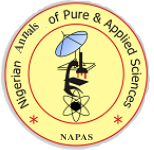Coffee and Vitamin-C Consumption on Selected Biochemical Indices and Antioxidant Activities in Adult Wistar Rats
DOI:
Keywords:
Coffee, Vitamin C, Antioxidant, ConsumptionAbstract
Coffee and vitamin C are staples in our daily lives. This study aimed to investigate the effects of sole and combined usage of coffee and vitamin C on antioxidant enzyme activities and biochemical parameters in selected organs in adult rats. 20 adult male Wistar rats were divided into four groups: Group A (distilled water), Group B (9 mg/kg b/w vit.C), Group C (33.4mg/kg b/w coffee) and Group D (9 mg/kg b/w vit.C + 33.4mg/kg b/w coffee 2 hours after). After 21 days, the rats were sacrificed, and selected organs were excised, weighed and analyzed for antioxidant enzyme activity. Blood samples were collected for biochemical evaluation. Vitamin C intake caused an increase in chloride levels and antioxidant enzyme levels. Coffee intake resulted in the highest increase in most biochemical parameters and antioxidant enzymes studied, and the intake of both gave significant increases in some and decreases in other parameters considered, as compared to the control group. This study indicates that vitamin C consumption causes a decrease while coffee consumption causes significant changes in antioxidant enzymes and biochemical parameters. Their combined administration increased total protein, sodium, chloride, and antioxidant enzymes in the organs of Wistar rats.
References
Abubakar, S.M. and Sule, M.S. (2010). Effect of Oral Administration of Aqueous Extract of Cassia occidentalisL. Seeds on Serum Electrolytes Concentration in Rats.Bayero Journal of Pure and Applied Sciences. 3(1): 183187.
Barham, D. and Trinder P. (1972). An improved color reagent for the determination of blood glucoseby the oxidase system. Analyst;97:142-145.
Beutler, E., Duron, O. and Kelly, B.M. (1963). Improved method for the determination of blood glutathione. Journalof Laboratory andClinicalMedicine;61:882-8.
Buege, J.A. and Aust, S.D. (1978). Microsomal Lipid Peroxidation Methods in Enzymology.Scienceand Education Publishing. 52: 302-310.
Cornelis, M.C. (2019). The Impact of Caffeine and Coffee on Human Health. Nutrients, 11(2), 416
Dórea, J.G and da Costa, T.H.M. (2005).Is coffee a functional food? British Journal of Nutrition, 93, 773782.
Engelbregt, M.J.T., van Weissenbruch,M.M., Popp-Snijders, C., Lips, P. andDelemarre-van de Waal, H.A. (2001). Body Mass Index, body composition, and leptin at onset of puberty in male and female rats after intrauterine growth retardation and after early postnatal food restriction. Pediatric Research;50;474-478.
Ferreira, T., Shuler, J., Guimarães, R. and Farah, A. (2019). CHAPTER 1: Introduction to Coffee Plant and Genetics , in Coffee: Production, Quality and Chemistry, 1-25.
Feyera, G.G. (2020). Embracing nutritional qualities, biological activities and technological properties of coffee byproducts in functional food formulation.Trends in Food Science & Technology, 104, 235-261.
Feyisa, T.O., Melka, D.S., Menon, M., Labisso, W.L., and Habte, M.L. (2019). Investigation of the effect of coffee on body weight, serum glucose, uric acid and lipid profile levels in male albino Wistar rats feeding on high-fructose diet. Laboratory animal research, 35, 29.
Góth, L. (1991). A Simple Method for Determination of Serum Catalase Activity and Revision of Reference Range. ClinicaChimicaActa, 196, 143-152.
Gray, J. (1998). "Caffeine, coffee and health."Nutrition & Food Science, 98(6): 314-319
Higdon, J.V. and Frei, B. (2006). Coffee and health: a review of recent human research. Critical Reviews In Food Science And Nutrition. 46: 101123.
Hoff, J. (2000). Methods of Blood Collection in the Mouse. Laboratory Animal;29: 47-53.
Johnston, C.S., Beezhold, B.L., Mostow, B. and Swan, P.D. (2007). Plasma vitamin C is inversely related to body mass index and waist circumference but not to plasma adiponectin in non-smoking adults. Journal ofNutrition;137:1757-1762.
Kotb, A. andAzzam, K.M.A. (2015). Effect of Vitamin C on Blood Glucose and Glycosylated Hemoglobin in Type II Diabetes Mellitus.World Journal of Analytical Chemistry,3(1A): 6-8.
Lara, D. R. (2010). Caffeine, mental health, and psychiatric disorders. Journal of Alzheimer's disease, 20(s1), S239-S248.
Lykkesfeldt, J., Michels, A. J., & Frei, B. (2014). Vitamin C. Advances in nutrition (Bethesda, Md.),5(1),1618.https://doi.org / 10.3945/an.113.005157
Lowry, O.H., Rosebrough, N.J., Farr, A.L. and Randall, R.J. (1951). Protein Measurement with Folin Phenol Reagent. Journal of Biological Chemistry, 193, 256-275.
Klag, M.J., Mead, L.A., LaCroix, A.Z., Wang, N.Y., Coresh, J., Liang, K.Y., Pearson, T.A. and Levine, D.M. (1994). Coffee intake and coronary heart disease. Annals of Epidemiology.4(6):425-33.
Magoshes, M. and Vallee, B.L. (1956).Flame Photometry and Spectrometry. New York Journal of InternationalScience. 2(1): 1316.
Massey, L.K. and Opryszek, A.A. (1990). Impact of gender and age on urinary water and mineral excretion responses to acute caffeine doses. Nutrition Research, 10( 7): 741-747.
McRae, M.P.(2008). Vitamin C supplementation lowers serum low-density lipoprotein cholesterol and triglycerides: a meta-analysis of 13 randomized controlled trials. Journal of chiropractic medicine, 7(2), 4858.
Misra, H.P. and Fridovich, I. (1972). The Role of Superoxide Anion in the Autoxidation of Epinephrine and a Simple Assay for Superoxide Dismutase. Journal of Biological Chemistry, 247, 3170-3175.
Moeenfard, M., Rocha, L. and Alves, A. (2014). Quantification of Caffeoylquinic Acids in Coffee Brews by HPLC-DAD.Journal of Analytical Methods in Chemistry,10 pages.
Oruganti, M. and Gaidhani, S. (2011). Routine bleeding techniques in laboratory rodents. International Journal of Pharmaceutical Sciences and Research. 2:516-552.
Rahman, K. (2007). Studies on free radicals, antioxidants, and co-factors. Clinical Interventions and Aging.2(2):219-36.
Schales, O. andSchales, S.S. (1941). A Simple and Accurate Method for Determination of Chloride in Biological Fluids. Journal of Biological Chemistry. 140(5): 879-882.
Tylewicz, U.,Nowacka, M., Martín-Garcí, B.,Wiktor, A. andCaravaca, A.M.G.(2018). 5- Target sources of polyphenols in different food products and their processing by-products, In: Polyphenols: Properties, recovery, and applications, Amsterdam, Elsevier, pp. 135175.
Van Slyke, D.D. and Neill, J.M. (1924). The determination of gases in blood and other solutions by vacuum and manometric measurements. Journal of Biological Chemistry. 61, 523.
Downloads
Published
How to Cite
Issue
Section
License
Copyright (c) 2022 AO Oyesola, SA Odukoya, IO Osonuga, ET George , IIG Owoeye , UJ James

This work is licensed under a Creative Commons Attribution-ShareAlike 4.0 International License.



 Contact Us
Contact Us Editorial Team
Editorial Team Join As A Reviewer
Join As A Reviewer  Request For Print Copy
Request For Print Copy


 Cprint Publishers
Cprint Publishers